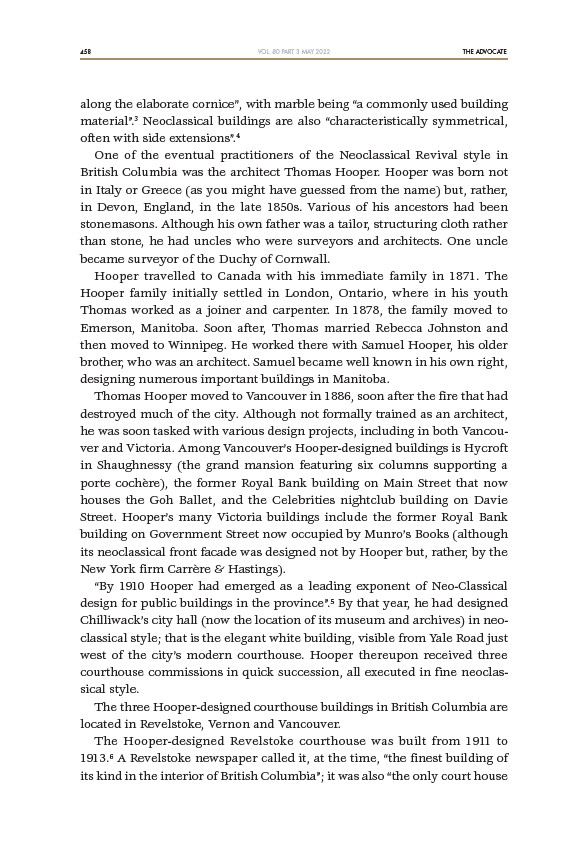
458 THE ADVOCATE
VOL. 80 PART 3 MAY 2022
along the elaborate cornice”, with marble being “a commonly used building
material”.3 Neoclassical buildings are also “characteristically symmetrical,
often with side extensions”.4
One of the eventual practitioners of the Neoclassical Revival style in
British Columbia was the architect Thomas Hooper. Hooper was born not
in Italy or Greece (as you might have guessed from the name) but, rather,
in Devon, England, in the late 1850s. Various of his ancestors had been
stonemasons. Although his own father was a tailor, structuring cloth rather
than stone, he had uncles who were surveyors and architects. One uncle
became surveyor of the Duchy of Cornwall.
Hooper travelled to Canada with his immediate family in 1871. The
Hooper family initially settled in London, Ontario, where in his youth
Thomas worked as a joiner and carpenter. In 1878, the family moved to
Emerson, Manitoba. Soon after, Thomas married Rebecca Johnston and
then moved to Winnipeg. He worked there with Samuel Hooper, his older
brother, who was an architect. Samuel became well known in his own right,
designing numerous important buildings in Manitoba.
Thomas Hooper moved to Vancouver in 1886, soon after the fire that had
destroyed much of the city. Although not formally trained as an architect,
he was soon tasked with various design projects, including in both Vancouver
and Victoria. Among Vancouver’s Hooper-designed buildings is Hycroft
in Shaughnessy (the grand mansion featuring six columns supporting a
porte cochère), the former Royal Bank building on Main Street that now
houses the Goh Ballet, and the Celebrities nightclub building on Davie
Street. Hooper’s many Victoria buildings include the former Royal Bank
building on Government Street now occupied by Munro’s Books (although
its neoclassical front facade was designed not by Hooper but, rather, by the
New York firm Carrère & Hastings).
“By 1910 Hooper had emerged as a leading exponent of Neo-Classical
design for public buildings in the province”.5 By that year, he had designed
Chilliwack’s city hall (now the location of its museum and archives) in neoclassical
style; that is the elegant white building, visible from Yale Road just
west of the city’s modern courthouse. Hooper thereupon received three
courthouse commissions in quick succession, all executed in fine neoclassical
style.
The three Hooper-designed courthouse buildings in British Columbia are
located in Revelstoke, Vernon and Vancouver.
The Hooper-designed Revelstoke courthouse was built from 1911 to
1913.6 A Revelstoke newspaper called it, at the time, “the finest building of
its kind in the interior of British Columbia”; it was also “the only court house